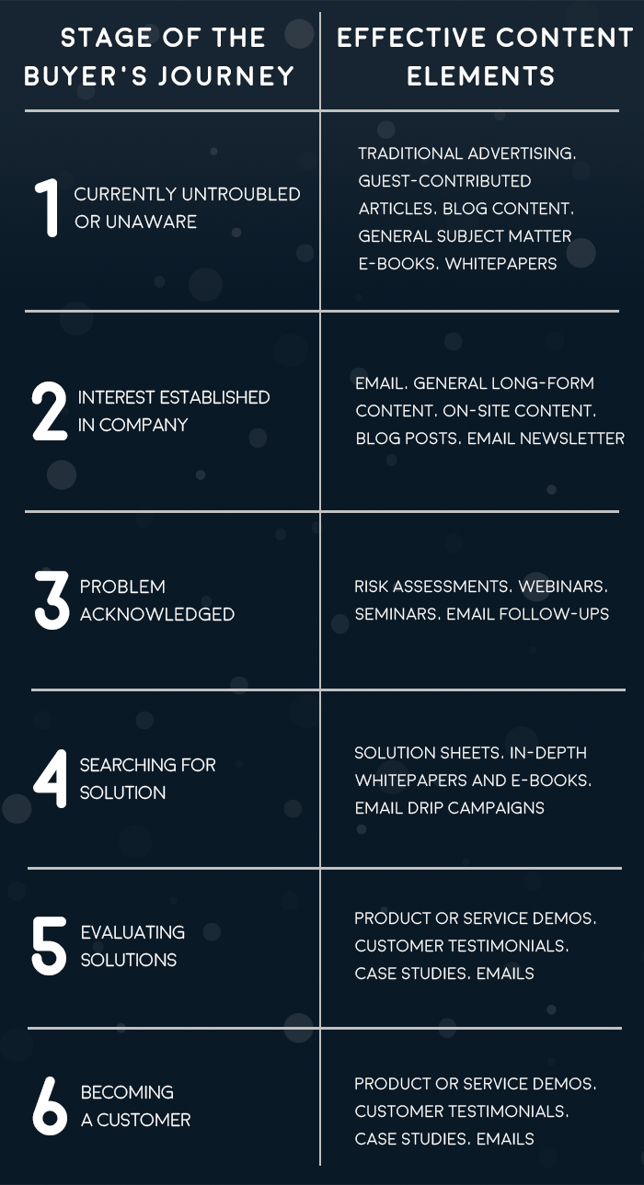 Buyers have become increasingly active participants in the sales process. With data and content so easily available, potential clients are able to identify, evaluate, and mitigate problems and solutions independently — without much direct interaction with your sales team at all. In fact, 67 percent of B2B buyers rely more on content to research and make purchasing decisions than they did in the previous year.
Buyers have become increasingly active participants in the sales process. With data and content so easily available, potential clients are able to identify, evaluate, and mitigate problems and solutions independently — without much direct interaction with your sales team at all. In fact, 67 percent of B2B buyers rely more on content to research and make purchasing decisions than they did in the previous year.
Knowing this, it’s important for sales and marketing teams to collaborate together on a content strategy that delivers the best, most relevant information to your prospects at any stage of their journey to your company so that when they are ready to interact with your sales team, they’re primed to move quickly to a close. And before that can be done, understanding the ins and outs of the typical buyer’s journey is critical.
The typical buyer’s journey consists of three stages: awareness, consideration, and decision. But my team and I have found success in further breaking down those stages into six stages that better reflect what our prospects are actually facing in their decision-making process. Those six stages look more like this:
-
Stage 1: Currently untroubled or unaware
-
Stage 2: Interest established in company
-
Stage 3: Problem acknowledged
-
Stage 4: Searching for solution
-
Stage 5: Evaluating solutions
-
Stage 6: Becoming a customer
Each prospect transitions through the stages of the buyer’s journey at his or her own pace. While it seems like a relatively simple process on the surface, it can become complex when the product or service you offer as a solution is sophisticated or when your average sales cycle is lengthy.
To ease that complexity, it’s your job as a marketer to strategize your content with the sales team and align collateral deliverables with the buyer’s journey. Over time, your team has produced a plethora of content: blog posts, guest-contributed articles, whitepapers, e-books, case studies, and more. And even with each of these pieces, you continue to create, publish, and distribute more content.
The challenge, then, lies in determining what piece or pieces of content best fit which stage of the buyer’s journey and can best serve your prospects in whatever stage they’re in.
Aligning Your Content With the Buyer’s Journey
Start by selecting the stage of the buyer’s journey where your marketing team can most benefit the sales team and deliver value to your visitors. Usually, a prospect will “tell” your sales team where he or she is in the process, either by the level of interest expressed to your sales team directly or by the level of activity and engagement with your site and content.
Identifying these behaviors will be helpful for your sales team in tracking a prospect’s journey, and it will be helpful for your marketing team when it comes to creating and delivering valuable content. Then, if your sales team needs more help generating new leads, create content for the first stage or two. And if your sales team needs help closing, focus your efforts on content for the fifth stage.
For example, if a prospect has established interest during the second stage, a general subject matter e-book, whitepaper, or blog post may be more appropriate than a technical comparison document or demo with a sales rep. Conversely, if a prospect has already read your top- and middle-of-the-funnel content and is in the fifth stage of evaluating solutions, a comprehensive case study, demo, or service presentation would be more valuable.
By understanding the stages of the buyer’s journey and the content elements that nurture visitors through each of them, your marketing team can develop an effective content marketing strategy — and your sales team can better engage, nurture, and close prospects.
Let’s take a look at what specific types of content perform well with prospects at various stages.
Understanding these effective content elements and at what stages they can and should be used to advance qualified prospects on their journey to a sale is critical to success for marketing and sales teams.
Discover how to create and use content to throughout your sales process by downloading your copy of “The Content Marketer’s Guide to Sales Enablement” below:




 Buyers have become increasingly active participants in the sales process. With data and content so easily available, potential clients are able to identify, evaluate, and mitigate problems and solutions independently — without much direct interaction with your sales team at all. In fact,
Buyers have become increasingly active participants in the sales process. With data and content so easily available, potential clients are able to identify, evaluate, and mitigate problems and solutions independently — without much direct interaction with your sales team at all. In fact, 




